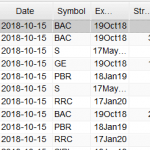This week brought another reason to get out of the casino, and to sell it short if you can tolerate some volatility.
On Friday the Japanese stock market ripped 6% higher and the European bourses were up 5% because their respective central bankers emitted some hints of more easing just ahead. Even the US market managed to find green for the week.
Apparently, the day traders and robo-machines think BTFD still works. But they are going to be sorely disappointed–just as they have been for nearly 700 days running.
That is, since the S&P 500 crossed the 1870 mark in early March 2014, there have been 35 attempts to rally higher. All of them have failed.

^SPX data by YCharts
Like the bloody trenches of World War I, the movement back and forth in “no man’s land” on the chart above has been pointless. At some juncture in the not too distant future, the stock averages are going to break this trading range, and plunge back down to earth.
In the meantime, you can’t blame the punters for trying. This week they succumbed once again to the BTFD delusion undoubtedly because the “more money” chorus grew ever louder as Friday approached.
That baleful refrain was led this time around by no less than the posse of oligarchs and apparatchiks assembled at Davos. Thus, when Mario Draghi, the world’s most ludicrous monetary dunce, let on that there were “no limits” on how much fraudulent credit could be emitted by the ECB’s printing press, he surely spoke a frightening truism.
Yet the world largest asset gatherer, Larry Fink, founder of $4.5 trillion BlackRock, gushed with an endorsement of what was pure monetary crackpottery:
“We’ve seen over the last few years you have to trust in Mario,” Laurence Fink, chief executive officer of BlackRock Inc., said in Davos. “The market should never, as we have seen now, the market should not doubt Mario.”
That’s right. You can’t make this baloney up. As Jeffery Snider shows in a nearby post, the massive ECB exercise in QE, which has already emitted some $700 billion in printing press airballs, has had no impact at all on its ostensible targets. Namely, the generation of a burst of private borrowing in order to stimulate spending and inflation.
In fact, European bank lending has been on the flat-line for 7 years and neither the ECB’s massive LTRO of 2012 or the QE explosion during 2015 has changed this trend. That’s because Europe is at “peak debt” and has been so ever since the original single currency borrowing binge peaked in 2008 (bottom panel).


Surely, Larry Fink knows that QE has been a failure in Europe, the US and everywhere else it has been tried. To wit, when the household and business sectors are at “peak debt” central bank money printing amounts to pushing credit on a credit string. It does nothing except inflate the value of existing financial assets and provides cheap carry trade funding for speculators.
That is actually the point, of course. Contemporary central bankers function like a team of monetary wranglers, herding the retail cattle toward the asset gatherers. And the latter always and everywhere manage to scalp a fee from investor portfolios being inflated by central bank action. It’s the modus operandi of our regime of bubble finance.
So the Larry Finks of the world have become cynical advocates for monetary policies that any half-wit can see amount to gibberish. Here is what the ECB said a year ago when it launched into it $1.4 trillion QE program:
The Governing Council took this decision in a situation in which most indicators of actual and expected inflation in the euro area had drifted towards their historical lows. As potential second-round effects on wage and price-setting threatened to adversely affect medium-term price developments, this situation required a forceful monetary policy response.
Asset purchases provide monetary stimulus to the economy in a context where key ECB interest rates are at their lower bound. They further ease monetary and financial conditions, making access to finance cheaper for firms and households. This tends to support investment and consumption, and ultimately contributes to a return of inflation rates towards 2%. [emphasis added]
Needless to say, the first paragraph above is errant nonsense. The idea that Europe was suffering from a dearth of inflation is essentially Keynesian newspeak. What these monetary cranks were talking about as requiring a “forceful monetary policy response” was the tiny area of relatively benign consumer inflation shown in the circle.

Even then, the 26-year average rate of consumer inflation shown above was 2.1%. By contrast, the slight relief experienced by wage earners and savers in recent months is entirely due to the great oil and commodity deflation now washing through the world economy.


















Leave A Comment